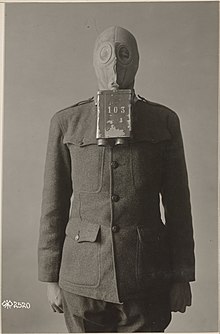
Back قناع الغاز Arabic Процівагаз Byelorussian Супрацьгаз BE-X-OLD Kedok gas BEW Противогаз Bulgarian Careta antigàs Catalan Ochranná maska Czech Gasmaske Danish Gasmaske German Gasmasko Esperanto
This article needs additional citations for verification. (July 2024) |
| Gas mask | |
|---|---|
 Two people wearing full-face elastomeric respirators with gas mask canisters | |
| Other name(s) | gas helmet, gasmask, gas mask canister |
| Regulated by | National Institute for Occupational Safety and Health, American National Standards Institute |
| Regulation | 42 CFR 84, ANSI Z88.7-2001, EN 14387 |
| NIOSH schedule | TC-14G (canister only) |




A gas mask is a piece of personal protective equipment used to protect the wearer from inhaling airborne pollutants and toxic gases. The mask forms a sealed cover over the nose and mouth, but may also cover the eyes and other vulnerable soft tissues of the face. Most gas masks are also respirators, though the word gas mask is often used to refer to military equipment (such as a field protective mask), the scope used in this article. Gas masks only protect the user from ingesting or inhaling chemical agents, as well as preventing contact with the user's eyes (many chemical agents affect through eye contact). Most combined gas mask filters will last around 8 hours in a biological or chemical situation. Filters against specific chemical agents can last up to 20 hours.[citation needed]
Airborne toxic materials may be gaseous (for example, chlorine or mustard gas), or particulates (such as biological agents). Many filters provide protection from both types.
The first gas masks mostly used circular lenses made of glass, mica or cellulose acetate to allow vision. Glass and mica were quite brittle and needed frequent replacement. The later Triplex lens style (a cellulose acetate lens sandwiched between glass ones)[1] became more popular, and alongside plain cellulose acetate they became the standard into the 1930s. Panoramic lenses were not popular until the 1930s, but there are some examples of those being used even during the war[clarification needed] (Austro-Hungarian 15M). Later, stronger polycarbonate came into use.
Some masks have one or two compact air filter containers screwed onto inlets, while others have a large air filtration container connected to the gas mask via a hose that is sometimes confused with an air-supplied respirator in which an alternate supply of fresh air (oxygen tanks) is delivered.
- ^ Rumpf, Hans. Gasschutz.